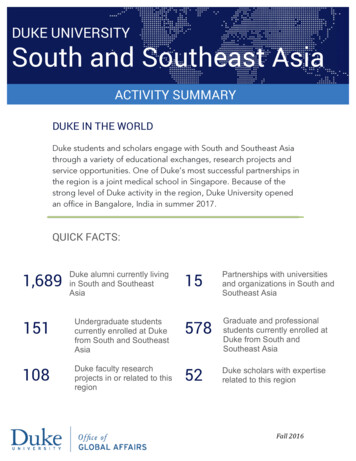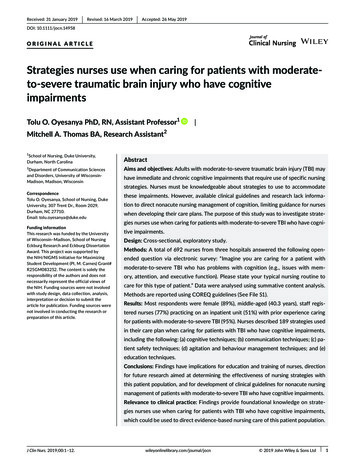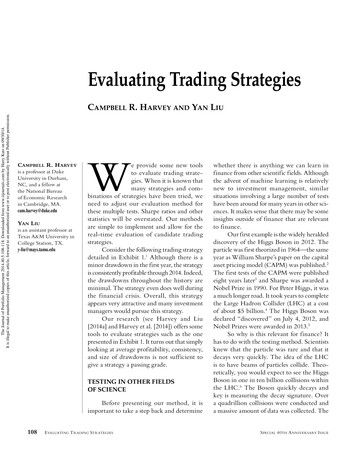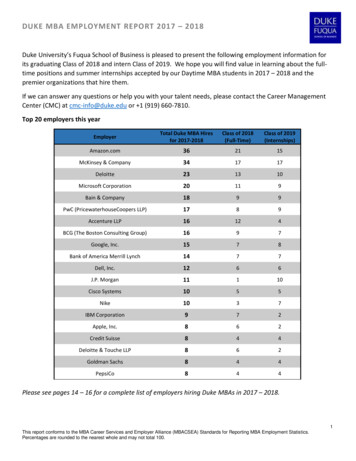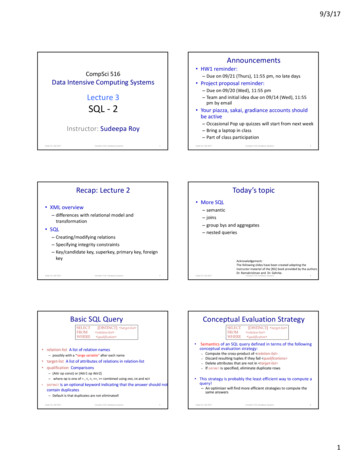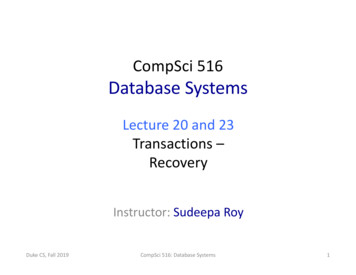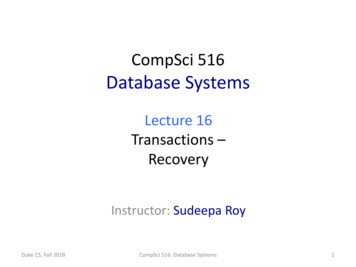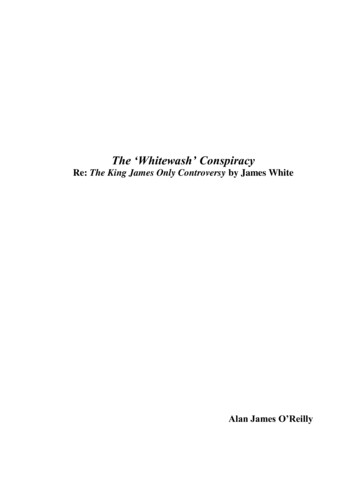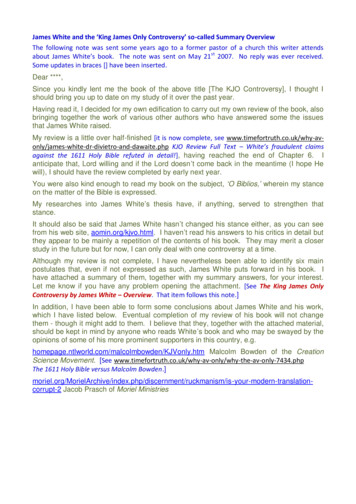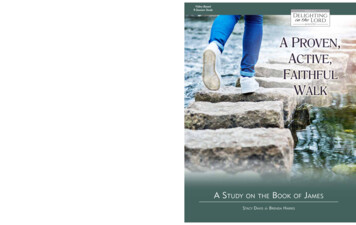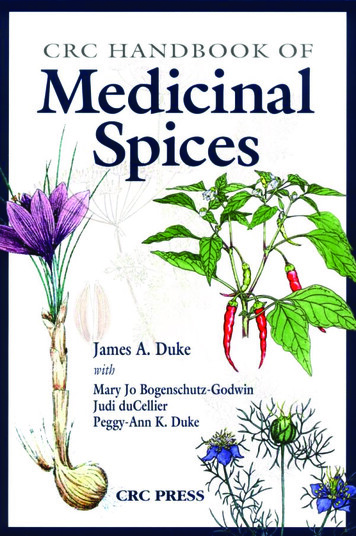
Transcription
CRC HANDBOOK OFMedicinalSpicesJames A. DukewithMary Jo Bogenschutz-GodwinJudi duCellierPeggy-Ann K. Duke – “Illustrator”CRC PR E S SBoca Raton London New York Washington, D.C.
Peggy-Ann K. Duke has the copyright to all black and white line illustrations.Library of Congress Cataloging-in-Publication DataCRC handbook of medicinal spices / James A. Duke [et al.].p. cm.Includes bibliographical references and index.ISBN 0-8493-1279-5 (alk. paper)1. Materia medica, Vegetable--Handbooks, manuals, etc. 2. Spices--Therapeuticuse--Handbooks, manuals, etc. 3. Herbs--Therapeutic use--Handbooks, manuals, etc. I.Duke, James A., 1929RS164 .C826 2002615′.321--dc212002067412This book contains information obtained from authentic and highly regarded sources. Reprinted material is quoted withpermission, and sources are indicated. A wide variety of references are listed. Reasonable efforts have been made to publishreliable data and information, but the author and the publisher cannot assume responsibility for the validity of all materialsor for the consequences of their use.Neither this book nor any part may be reproduced or transmitted in any form or by any means, electronic or mechanical,including photocopying, microfilming, and recording, or by any information storage or retrieval system, without priorpermission in writing from the publisher.The consent of CRC Press LLC does not extend to copying for general distribution, for promotion, for creating new works,or for resale. Specific permission must be obtained in writing from CRC Press LLC for such copying.Direct all inquiries to CRC Press LLC, 2000 N.W. Corporate Blvd., Boca Raton, Florida 33431.Trademark Notice: Product or corporate names may be trademarks or registered trademarks, and are used only foridentification and explanation, without intent to infringe.Visit the CRC Press Web site at www.crcpress.com 2003 by CRC Press LLCNo claim to original U.S. Government worksInternational Standard Book Number 0-8493-1279-5Library of Congress Card Number 2002067412Printed in the United States of America 1 2 3 4 5 6 7 8 9 0Printed on acid-free paper 2003 CRC Press LLC
AcknowledgmentsPerhaps it is unusual to acknowledge one's coauthors in a new book, but I sure wish to acknowledgemine for their patience and perseverance with this new book. To Mary Jo Bogenschutz-Godwinfor tidying up my most untidy first drafts, and for querying our database, after updating the databaseat the United States Department of Agriculture (USDA), working with my former USDA colleaguesJimmie Mowder, Ed Bird (deceased), and Quinn Sinnott. I am of course indebted to the USDA formaintaining the database these many years and to Dr. Alan Stoner for facilitating this. Readers ofthe book will realize the importance of the USDA database in shaping some of our new conceptsand even for suggesting new indications for old spices. To Judi duCellier who, for more than 25years, has quietly, and without complaining, struggled not only with my illegible handwritten notes,complete incompetence at the computer, quick reprioritizations, and now terminal dyslexia (doublemeaning intended), and produced useful documents that I mold into first drafts. To Peggy-Ann K.Duke, botanist and co-compiler, for closer to five decades, to whom both the world and I areindebted for her talented art, learned as a botanist while sharing with me the wonders of botany atthe University of North Carolina, under out great teachers, alphabetically, Drs. J. E. Adams, C. R.Bell, J. N. Couch (who swore I could not be both a botanist and a musician; my music proves himright), Victor Greulach, A. E. Radford, and H. R. Totten, who kept us interested in botany. Thatinterest is still today reflected, in the seven plus decades of Peggy's and my lives, in my GreenFarmacy Garden in Maryland and the ReNuPeRu Garden in Peru which I started nearly a decadeago. It now functions fine without me, thanks to Pamela Bucur de Arevalo and the wonderfulworkers at the Explorama Lodges of Amazon Peru, where Peggy and I shared the turning of theNew Millennium. Coincidentally, we may be leading a course there at the ReNuPeRu garden nextyear, teaching Latin Americans how to better grow and process some herbs, medicinal plants andspices covered in this book. As I have struggled with this book, I have had the marvelous luck tohave acquired a new director for my Green Farmacy Garden, phytopathologist Holly Shull Vogel.In a sense, she keeps the Green Farmacy Garden alive through unfailing labors, too often all herown. She shares my vision of teaching America about the best and safest medicines, like some ofthe spices in this book. Illustrations for the onion, frankencense, cassia, cinnamon and cassia, garlic,bayleaf, and myrtle are used with the permission of Duke, J., Medicinal Plants of the Bible, TradoMedic Books, Buffalo, New York, 1983. All other illustrations in this book are courtesy of PeggyAnn K. Duke. Our thanks to those patient people at CRC who tolerated our frequent changes ofdirection, especially Barbara Norwitz, Sara Kreisman, and Joette Lynch. And to you, the reader,and your health, may the spices of life prolong and enhance the quality of your lives, saving youfrom what is believed to be America's biggest killer, Adverse Drug Reactions (ADR's) accordingto The Journal of the American Medical Association, May 1, 2002.James A. Duke 2003 CRC Press LLC
The AuthorJames A. “Jim” Duke, Ph.D., is a Phi Beta Kappa graduate of the University of North Carolina,where he received his Ph.D. in Botany. He then moved on to postdoctoral activities at WashingtonUniversity and the Missouri Botanical Gardens in St. Louis, Missouri, where he assumed professorand curator duties, respectively. He retired from the United States Department of Agriculture(USDA) in 1995 after a 35-year career there and elsewhere as an economic botanist. After retiring,he was appointed Senior Scientific Consultant to Nature’s Herbs (A Twin Labs subsidiary), and toan online company, ALLHERB.COM. He currently teaches a master’s degree course in botanicalhealing at the Tai Sophia Institute in Columbia, Maryland.Dr. Duke spends time exploring the ecology and culture of the Amazonian Rain Forest and sitson the board of directors and advisory councils of numerous organizations involved in plantmedicine and the rainforest. He is updating several of his published books and refining his onlinedatabase, http://www.ars-grin.gov/duke/, still maintained at the USDA. He is also expanding hisprivate educational Green Farmacy Garden at his residence in Fulton, Maryland. 2003 CRC Press LLC
ContentsIntroductionAbbreviationsCatalog of Spices (A to Z)Reference AbbreviationsReferences 2003 CRC Press LLC
IntroductionYou remember the days a decade ago when I celebrated the 500th anniversary of Columbus’“Discovery of America” and the Native Americans who had colonized it some 25,000 yearsearlier and been visited by Scandinavians a bit earlier. I believe Leif Ericsson also encounteredNative Americans when he landed nearly 500 years earlier, up around Vinland, north of theUnited States. In reflecting the anniversary of Columbus’ voyage, I often make the comment thatColumbus set sail seeking black pepper and black Indians and instead found red Indians and redpepper, changing the cuisine and the medicine of the world and reshaping everyone’s food basketand medicine chest significantly.The travels of Columbus opened up one of the world’s greatest exchanges of flora and fauna,and yes even germs, including some lethal smallpox germs, as well as higher plants (many neverhaving been seen before outside America) and animals. This has laxly been termed the “Columbianexchange,” the rapid movement, to and fro, of useful plants and animals, some for the first time,from continent to continent.Frequently, the major producers of spices are not regions to which the species originallybelonged, but areas of introduction as a result of the Columbian exchange of plants and animalsaround the world. I got very excited at what I learned in preparing my talk, Spice rack/medicinechest—Five hundred years after Columbus, presented under the auspices of Oldways in Spain thefollowing year (Duke, 1991, 1992). Spices are important medicines that have withstood the empirical tests of millennia. New books come out every year embracing the time proven medicinalefficacy of one spice or another. Chile, garlic, ginger, onion, pepper, and turmeric are almost aspopular, and deservedly sso, as medicines as they are as spices.I’ll freely dispense sage advice:Sage is an herb, not a spice!Herbs are tasty temperate shoots!Spices, barks, buds, seeds, roots, and fruits!That’s why spices are much higher priced!I’ll not labor with the technical and varying definitions of spices as opposed to culinary herbs,but I summarized much of it in the verse above. Overgeneralizing, culinary herbs are temperateleafy shoots used culinarily to flavor other dishes. And I know of no culinary herb that lacksmedicinal activities. (Mentha requienii is so small that it seems not to have evolved any seriousmedicinal folklore; its the only popular herb for which I found no published medicinal folklore.)And overgeneralizing, spices are more often tropical and involve other plant parts, not just theleaves and shoots. But there is no fine line between spice and herb, and furthermore no fine linebetween, herb, spice, food, and medicine. Chile, garlic, ginger, onion, pepper, and turmeric are allherbaceous in the botanical sense of the word, i.e., not producing any wood; they are all oftenincluded in the spice charts and statistics of the world; they are all foods; they are all medicines.I have intentionally omitted from this book many of the better-known temperate culinary herbs.Anethum graveolens (dill), Brassica sp. (mustard), Coriandrum sativum (coriander), Cuminumcyminum (cumin), Foeniculum vulgare (fennel), Mentha spp. (peppermint, spearmint, etc), Origanum vulgare (oregano), Ocimum basilicum (basil), Papaver somniferum (poppy), Petroselinumcrispum (parsley), Pimpinella anisum (aniseed), Salvia officinalis (sage), and Thymus vulgaris(thyme). These are clearly culinary and medicinal herbs, and all are carried in the USDA spicestatistics. Most are also covered in detail and illustrated in Ed. 2 of our CRC Handbook of Medicinal 2003 CRC Press LLC
Herbs (Duke et al., 2002). Many of them are also covered in my books on Medicinal Plants of theBible (Duke, 1983, 1999), Culinary Herbs (Duke, 1985), and Living Liqueurs (Duke, 1987).Under indications, I list most published iindications that crossed my desk, alphabetically,with each indication followed by the ‘f’ or numerical score for efficacy, followed by the citationfor the source. It was with some trepidation that I converted more specific terms such asarthritis to arthrosis, and bronchitis to bronchosis; but I think that was a more economical(space wise) was of presenting the data. Classically the suffix ‘itis’ means inflammation and‘osis’ means ailment of. Thus arthritis is inflammation of the joint, and arthrosis is broader,meaning an ailment in the joint. Where some author just said “for joint problems,” that became‘arthrosis,’ but where they were more specific and said inflammation of the joint it means themore specific ‘arthritis.’ Towards the end I aggregated both under ‘arthrosis.’ Many peoplewill dislike the fact I converted all the more specific -itis etntries to -osis, rather than somewhatredundantly include both.In the indications paragraph, you see parenthetical numbers followed by three-letter abbreviations (abbreviation of source) or an alphanumeric X-1111111 to identify PubMed citations.A parenthetical efficacy score of (1) under an activity or indication means that a chemical in theplant or an extract of the plant has shown the activity or proven out experimentally (animal, notclinical) for the indication. This could be in vitro animal or assay experiments. A hint; not realhuman proof! Nothing clinical yet! I score (2) here if the aqueous extract, ethanolic extract, ordecoction or tea derived from the plant has been shown to have the activity or to support theindication in clinical trials. Commission E (KOM) and Tramil Commission (TRA) approvalswere automatically scored (2) also, as they represented consensus opinions of distinguishedpanels. The rare (3) scoring for efficacy means that there are clinical trials showing that the plantitself (not just an extract or phytochemical derived therefrom) has the indication or activities.The solitary (f) in many of the citations means that it is unsupported folk medicine, or I havenot seen the science to back it up. The three-letter abbreviations are useful short citations of thereferences consulted in arriving at these numbers. I have by no means cited every source here.But unlike KOM and hopefully better than PDR for Herbal Medicines, ed. 1 and 2 (PHR andPH2), I indicate at least one source for every indication and activity I report. Commission E(Blumenthal et al., 1998) did not list sources.And after much soul searching, I have decided to spare our readers the long list of all thephytochemicals reported from each of these spices. These are available for your purview on theUSDA phytochemical database (http://www.ars-grin.gov/duke/). Many of these are detailed paragraphically in Duke and duCellier (1993). Instead, I have pulled forward for you some of the majorcompounds that may underlie many of the reported activities of these species. These data, too, areavailable on our USDA website, where I also list the source of each data entry. Another new featureis the addition of our Multiple Activity queries, not yet available on the USDA database. With theable assistance of Sue Mustalish, R.N., and Leigh Broadhurst, Ph.D. and certified nutritionist, Ihave accumulated many of the activities that might contribute to the alleviation, correction and/orprevention of an ailment. The computer then searches for phytochemicals reported from that spicethat have the desired activities. As you will see, this shows that the spice is a menu of biologicallyactive compounds that might help the malady. I suspect the body is skillful at sifting through thosephytochemicals with which your genes have co-evolved for so many millions of years. This doesnot prove that the spice will help; it just proves that the spice contains phytochemicals, often bythe dozens, that have been shown to have useful activities.In this book, I focus on the medicinal application of spices. If you need to know more aboutquality specifications and the like, I suggest you consult Purseglove et al. (1981) or Tainter andGrenis (1993). I feel a bit stronger about the medicinal potential of spices than did Purseglove,who said, “Spices are no longer as important medicines as they were in the past, but some haveminor uses in modern pharmacopoeias, of which probably the most important is Capsicum.” 2003 CRC Press LLC
(Capsicum shows up in proprietary preparations from A to Z, Axsain to Zostrix, JAD.) As amatter of fact, I agree with Purseglove that the spices did suffer a decline in both medicinalimportance and relative value. But I predict that such spices as capsicum, cinnamon, garlic,ginger, onion, and turmeric will assume relatively more medicinal importance again, as theeconomic costs and knowledge of the side-effects of prescription pharmaceuticals increase. Yousee, each spice contains thousands of useful phytochemicals. Pharmaceuticals usually containonly one or two.I actually believe that many educated Americans, after reading this book, may sometimeshead to the spice chest for minor ailments instead of the medicine chest. When one considersthat 80% of the world cannot afford our pharmaceuticals, I’ll speculate that already morehumans use spices as medicines than use prescription pharmaceuticals. I’ll even put the spicesup against the pharmaceuticals, the garlic against the statins for high cholesterol, the gingeragainst antacids for ulcer and even for morning sickness (they don’t have an approved pharmaceutical), capsaicin vs. Acyclovir for shingles, and turmeric vs. Vioxx for arthritis and vs.Cognex for Alzheimer’s.I could start my spice story 500 years ago when Columbus discovered America, or50,000–60,000 years ago, when humans were learning that wrapping their food in leaves keptthe ashes off, retained the juices, and sometimes improved the flavor, or even tenderized toughmeat; or ca. 5000 years ago, when garlic and onion were contributing to Egypt’s pyramids,ginger joining early Chinese medicine chests, pepper penetrating Ayurvedic medicine chests,and sesame spicing Assyrian wines. Babylonians, ca. 2700 B.P. (before present), were familiarwith cardamom, coriander, garlic, saffron, thyme, and turmeric. Assyrians, ca. 2650 B.P., werefamiliar with anise, cardamom, coriander, cumin, dill, garlic, myrrh, poppy, saffron, sesame,thyme, and turmeric. Around 2400 B.P., the father of medicine, Hippocrates, said “let food beyour medicine, medicine your food.” Already, he was familiar with cinnamon, coriander,marjoram, mint, saffron, and thyme. In those days, spices were as important for medicine,embalming, preserving food, and masking bad odors, as they were for more mundane culinarymatters. Now, in the new millennium, I may be reverting to the Hippocratean corollary: letfood be your medicine. Many Americans are a bit alarmed by Journal of the American MedicalAssociation statistics (JAMA p. 2891, 1987) that the “prevalence of fatal drug reactions hasbeen estimated at 0.01% for surgical in-patients and 0.1% for medical in-patients.” Thatindicates that at least 1 in 1000 patients in a hospital will die of iatrogenic causes. Withmedicine getting more and more expensive and impersonal, and high iatrogenic death rates asquoted from JAMA, people are actually afraid of their doctors and/or health plans. I’ve beenwith the same health plan for nearly two decades. On visits to my neurosurgeon, my chartsand magnetic resonance imagery (MRI) were lost, so that I wasted an afternoon. On one visitto the GP, I saw the erroneous comment that I was on the contraceptive pill. When one GPprescribed a sulfa drug for sinusitis, he had to ask me if I was allergic to sulfa. This shouldalready be in his computer, as should my blood type. He could produce neither. Having beenwith a plan that long, I find it disgraceful that they can’t tell me instead of asking me. That’swhy I’m inclined to listen to news that garlic might cure sinusitis, rhinitis, even meningitis.And that’s why all this renewed interest in spices and foods as pharmaceuticals, an aversivereversion to Hippocrates. So spices are working their way back into the medicine chest, withmany good reasons, economic, gustatory, and salutory.FORMATAfter some deliberation I have limited the entries on individual spice species to five major headings— Medicinal Uses, Indications, Other Uses, Cultivation, and Chemistry. 2003 CRC Press LLC
MEDICINAL USESSince the medicinal uses are the most important to me, they are first. I cover some of the majorhistorical and / or new facts from current findings, chemical or clinical abstracts. The folk and realmedicinal potential of the species are noted.INDICATIONSThe indications are listed in a concise format. The indications are followed by a parenthetical scoreand abbreviated reference citation(s). The scores are: f folkloric only; 1 with in vitro, animalor chemical but no clinical rationale; 2 with positive clinical trials (or Commission E approval)of extracts of the spice; or 3 with positive clinical trials (or Commission E approval) for the spiceitself, as in whole garlic. The score is followed by an abbreviation of one or more references thathelped me arrive at the score. The biological activities have been omitted, many of which arecovered in my CRC Handbook of Medicinal Herbs, 2nd ed., published in July 2002. About 75%of these spices were covered, including sections on activities; indications; dosage; contraindications,interactions and side effects; and extracts. For the better known spices, I include a few of the dozensof possible Multiple Activity queries of the USDA database, delineating the compounds in a plantthat might contribute to several biological activities, each of which might contribute to the resolutionof an “ indication”.OTHER USESI discuss the historical and/or conventional culinary uses and other non-medicinal uses of the spice.Here you will also find occasional references to pesticidal activities.CULTIVATIONI have compiled information on cultivation of the spice, sometimes tempered by my hands-onexperiences in the Green Farmacy Garden, in Howard County Maryland, where I have grown morethan half of the spices covered in this book.CHEMISTRYAll of the chemicals are not listed. Remember that each plant species contains hundreds ofchemicals in the part per million levels, and thousands in the parts per trillion levels. Here, Iselect a few of those I deem more important, or about which there is current breaking news.Rarely, if ever, is any phytochemical working alone; more likely, phytochemicals are actingsynergistically with other compounds in a species. Often such phytochemicals protect the spicefrom its natural enemies, synergetically. Then, we humans borrow them, to protect us fromour enemies, synergetically. For extended chemical information, readers are referred to earlierCRC compendia:Duke, J.A., CRC Handbook of Phytochemical Constituents in GRAS Herbs and Other Economic Plants, CRCPress, Boca Raton, FL, 1992Duke, J.A., CRC Handbook of Biologically Active Phytochemicals and Their Activities, CRC Press, BocaRaton, FL, 1992Beckstrom-Sternberg, S. and Duke, J. A., Handbook of Mints (Aromathematics): Phytochemicals and Biological Activities, CRC Press, Boca Raton, Fl, 1996USDA database (http://www.ars-grin.gov/duke) 2003 CRC Press LLC
2003 CRC Press LLC
DATELINE — SPICE TIMETABLE 60,000,000 B.P. Flowering plants, the subject of this book, emerge and begin to evolvephytochemicals defensive against phytovores. 6,000,000 B.P. Primates evolve into man who begins co-evolving with the floweringplants, some edible, some medicinal, some poisonous. 50,000 B.P. Man learns of the culinary attributes of leaves wrapped around meat forcooking (McCormick, 1981). 18,000 B.P. Man crosses the Bering Bridge, opening up the New World for the discoveryof the New World spices, Capsicum, Cunila, Osmorrhiza, Peumus, Pimenta, Sassafras,Vanilla. 12,000 B.P. Boldo Man in Monte Verde Chile, with boldo and a couple dozen medicinalplants. 7000 B.P. Hot peppers cultivated in South America (Wood, 1993). 6000 B.P. Sumerians use licorice and opium; Fenugreek identified in Iraq. 5000 B.P. Charak, the father of Ayurvedic medicine, claimed that garlic “maintains thefluidity of blood and strengthens the heart” (Rahman, 2001). Not known in the wild, itwas cultivated in the Middle East at least 5000 years ago. 5000 B.P. Ancient historians equate the ownership of ginger or its trade routes withprosperity (Schulick, 1996). 4700 B.P. Cassia recorded in China (Bown, 2001). 4500 B.P. Andean Indians already using coca, the source of cocaine. 4000 B.P. Shen Nong first Ben Cao or native herbal with 365 drugs, Cassia, ephedra,ginseng, rhubarb. Garlic already in use in China (consumed with raw meat), introducedinto Japan (Rivlin, 2001). 3900 B.P. Sesame oil expressed in Urartu (now Armenia) (TAD). 3730 B.P. Joseph sold to Ishmaelites with camels taking spices, balm, and myrrh toEgypt (Genesis 37) (PEA). 3600 B.P. Cassia recorded in Egypt. 3500 B.P. Art at Queen Hatshepsut’s temple at Luxor showed potted frankincense,possibly used in rejuvenating face masks (Bown, 2001). 3500 B.P. King Tut’s Tomb contained 6 cloves garlic (Fulder dates it 4000 B.C.; Rivlin1500). 3500 B.P. Papyrus Ebers 800 prescriptions; 700 mostly plant drugs compounded sometimes with beer, honey, milk, or wine. The Codex Ebers, ca. 1500 B.C., is one of theearliest sources indicating prescription of garlic to treat cancerous growths. The Codexalso suggests garlic, as I do today, for circulatory ailments, general malaise, and infestations with insects and parasites (Rivlin, 2110). Fenugreek suggested to induce childbirth(Bown, 2001). Probably the first mention of sesame (Bown, 2001). 3400 B.P. Poppy, its seeds or its opium, apparently in culinary and/or medicinal use byCretans, Egyptians, and Sumerians. 3000 B.P. Solomon immortalizes many Biblical spices in his song of Solomon (camphire,cinnamon, frankincense, myrrh, pomegranate, saffron, spikenard). The Queen of Shebavisits, bringing as gifts of state “camels that bear spices” (Chronicle 9) (PEA). 2775 B.P. Olympic Games founded, champions crowned with laurel ( bayleaf). 2700 B.P. Babylonians familiar with cardamom, coriander, garlic, saffron, thyme, andturmeric. 2650 B.P. Assyrians familiar with anise, cardamom, coriander, cumin, dill, garlic, myrrh,poppy, saffron, sesame, thyme, and turmeric. 2500 B.P. Chinese courtiers were said to hold a clove in their mouth when addressingan emperor. 2003 CRC Press LLC
2500 B.P. Sasruta writings in India mention cardamom, cinnamon, pepper, and turmeric. 2400 B.P. Hippocrates—“First, do no harm. Second, let food be your farmacy.” Usedgarlic for pulmonary complaints, abdominal and uterine growths (read cancer), and as acleansing agent and purgative. Also familiar with cinnamon, coriander, marjoram, mint,saffron, and thyme. 2350 B.P. Aristotle catalogued medicinal properties of many herbs and spices. 2335 B.P. Alexander the Great’s army plunders Gaza, sending its frankincense to Greece. 2300 B.P. Theophrastus, “Father of Botany,” described medicinal attributes of many spices,including black pepper and long pepper. He noted that hot sunny regions produced the mostaromatic spices. Licorice suggested for asthma, bronchoses, cough, pulmonoses (FAY). 2165 B.P. Death of Chinese Princess Tai, buried with cinnamon, galangal, ginger, and pepper. 2050 B.P. Mithridates, “The Royal Toxicologist,” rhizomatists offering ginger. 2050 B.P. First mustard seed brought to England by the Romans (McCormick, 1981). 2050 B.P. Caius Plinus Secundus (A.D. 23–79), “Pliny the Elder,” Natural History—Medical Bot, listed 23 uses for garlic against infections and toxins (anticipating p450–2E1activities on toxins (Rivlin, 2001) and maybe even antianthrax (JAD). Pliny consideredlicorice native to Sicily). Birth of Jesus. Wise men bring Frankincense and Myrrh. Crucifixion. Christ given “gall” on the cross, perhaps opium. Many herbs and spices mentioned in the Bible (almond, anise, bay, black cumin, caper,carob, cassia, cinnamon, coriander, cumin, dill, fenugreek, frankincense, galbanum,garlic, juniper, leek, marjoram or Biblical hyssop, mint, mustard, myrrh, myrtle, onion,poppy, rue, saffron, sage, spikenard, storax, possibly turmeric and wormwood). Cloves reach China, India, Rome as spice (Bown, 2001). 47 A.D. Pedanios Dioscorides (first century A.D.) “Materia Medica,” followed the Romanarmies. Recommended garlic to clean the arteries, for GI disorders, for joint disease andseizures (Rivlin, 2001). Boiled garlic and oregano for bedbugs and lice (Fulder, 1997). Gingersuggested as aphrodisiac (Schulick, 1996). Sesame seed sprinkled on bread (Bown, 2001). 130–200 A.D. Galen medicinal extracts of galenicals containing dozens of ingredients(opium). 200 A.D. Ginger taxed in Rome, first listed as medicinal in China (Bown, 2001). 300 A.D. Bower Manuscript. Garlic for debility, dyspepsia, fatigue, and infections. 410 A.D. Alaris, the Visigoth, subjugates Rome and demands 3,000 lb peppercorns astribute (McCormick, 1981). 570 A.D. Birth of Mohammad. 595 A.D. Mohammad marries Khadija, and they run a Meccan shop trading in orientalspices, frankincense and myrrh. Muslims consolidate monopoly on spice trade, whichlasts for centuries. The Qu’ran hints that ginger (not identified in the Bible) is a heavenlyand spiritual beverage (Schulick, 1996). 600 A.D. Clove and nutmeg listed as medicinal herb in China (Bown, 2001). 720 A.D. Cardamon mentioned in China as medicine (Bown, 2001). Late Eighth Century. First drug stores in Bagdad; Muslims and Arabs rescued many ofthe books from Christian/Roman wars; the first apothecary camphor, cloves, cubebs,nutmeg, tamarind. 980–1037 A.D. Avicennia (“Ibn Sina”), Arabic scholar, Persian physician, poet, writerUnani or Greek Canon Of Medicine. 200 Publications. 1098–1179 A.D. Hildegard of Bingen, Benedictine nun in Rhineland. She believed thatraw garlic was more effective than cooked. I still believe this. She predicts use of celeryin “gicht.” She also covered cinnamon, cloves, cubeb (a type of pepper), fenugreek,galangal, ginger, licorice, nutmeg, pepper, zedoary, etc., plus dozens of culinary herbs. 1280 A.D. Marco Polo observed ginger cultivated in China and India. 2003 CRC Press LLC
1305 A.D. Edward I levies a tax on licorice to help pay for the London Bridge (FAY). 1350 A.D. Black Death kills 25 million Europeans (PEA). Spices widely tried butunsuccessfully, with the possible exception of garlic. 1368–1654 A.D. Bastard cardamom first mentioned as Chinese medicine. Ming Dynasty(Bown, 2001). 1447 A.D. English outlaw adulteration of spices (McCormick, 1981). 1475 A.D. Bjornnson’s Icelandic manuscript, before the invention of gin, prescribesjuniper-spiced wine for cold and headache (CEB). 1492 A.D. Columbus seeks a short route to the orient and black Indians and black pepperbut instead finds red Indians and red pepper. Folklore says he was guided to Terra Firmaby the aroma of sassafras. 1500 (1493–1541) A.D. Paracelsus, the first reductionist (chemicals are responsible formedicinal activities of herb) disliked the vogue fascination with exotic imported herbs. 1502 A.D. Ferdinand and Isabella tell Columbus
Most are also covered in detail and illustrated in Ed. 2 of our CRC Handbook of Medicinal 2003 CRC Press LLC Herbs (Duke et al., 2002). Many of them are also covered in my books on Med
